Mathematical Analysis I
Prefaces
Preface to the Second English Edition
Preface to the First English Edition
Preface to the Sixth Russian Edition
Preface to the Second Russian Edition
From the Preface to the First Russian Edition
Contents
Chapter 1: Some General Mathematical Concepts and Notation
1.1 Logical Symbolism
1.1.1 Connectives and Brackets
1.1.2 Remarks on Proofs
1.1.3 Some Special Notation
1.1.4 Concluding Remarks
1.1.5 Exercises
1.2 Sets and Elementary Operations on Them
1.2.1 The Concept of a Set
1.2.2 The Inclusion Relation
1.2.3 Elementary Operations on Sets
1.2.4 Exercises
1.3 Functions
1.3.1 The Concept of a Function (Mapping)
1.3.2 Elementary Classification of Mappings
1.3.3 Composition of Functions and Mutually Inverse Mappings
1.3.4 Functions as Relations. The Graph of a Function
a. Relations
b. Functions and Their Graphs
1.3.5 Exercises
1.4 Supplementary Material
1.4.1 The Cardinality of a Set (Cardinal Numbers)
1.4.2 Axioms for Set Theory
1.4.3 Remarks on the Structure of Mathematical Propositions and Their Expression in the Language of Set Theory
1.4.4 Exercises
Chapter 2: The Real Numbers
2.1 The Axiom System and Some General Properties of the Set of Real Numbers
2.1.1 Definition of the Set of Real Numbers
2.1.2 Some General Algebraic Properties of Real Numbers
a. Consequences of the Addition Axioms
b. Consequences of the Multiplication Axioms
c. Consequences of the Axiom Connecting Addition and Multiplication
d. Consequences of the Order Axioms
e. Consequences of the Axioms Connecting Order with Addition and Multiplication
2.1.3 The Completeness Axiom and the Existence of a Least Upper (or Greatest Lower) Bound of a Set of Numbers
2.2 The Most Important Classes of Real Numbers and Computational Aspects of Operations with Real Numbers
2.2.1 The Natural Numbers and the Principle of Mathematical Induction
a. Definition of the Set of Natural Numbers
b. The Principle of Mathematical Induction
2.2.2 Rational and Irrational Numbers
a. The Integers
b. The Rational Numbers
c. The Irrational Numbers
2.2.3 The Principle of Archimedes
2.2.4 The Geometric Interpretation of the Set of Real Numbers and Computational Aspects of Operations with Real Numbers
a. The Real Line
b. Defining a Number by Successive Approximations
c. The Positional Computation System
2.2.5 Problems and Exercises
2.3 Basic Lemmas Connected with the Completeness of the Real Numbers
2.3.1 The Nested Interval Lemma (Cauchy-Cantor Principle)
2.3.2 The Finite Covering Lemma (Borel-Lebesgue Principle, or Heine-Borel Theorem)
2.3.3 The Limit Point Lemma (Bolzano-Weierstrass Principle)
2.3.4 Problems and Exercises
2.4 Countable and Uncountable Sets
2.4.1 Countable Sets
2.4.2 The Cardinality of the Continuum
2.4.3 Problems and Exercises
Chapter 3: Limits
3.1 The Limit of a Sequence
3.1.1 Definitions and Examples
3.1.2 Properties of the Limit of a Sequence
a. General Properties
b. Passage to the Limit and the Arithmetic Operations
c. Passage to the Limit and Inequalities
3.1.3 Questions Involving the Existence of the Limit of a Sequence
a. The Cauchy Criterion
b. A Criterion for the Existence of the Limit of a Monotonic Sequence
c. The Number e
d. Subsequences and Partial Limits of a Sequence
3.1.4 Elementary Facts About Series
a. The Sum of a Series and the Cauchymat]Cauchy, A. Criterion for Convergence of a Series
b. Absolute Convergence. The Comparison Theorem and Its Consequences
c. The Number e as the Sum of a Series
3.1.5 Problems and Exercises
3.2 The Limit of a Function
3.2.1 Definitions and Examples
3.2.2 Properties of the Limit of a Function
a. General Properties of the Limit of a Function
b. Passage to the Limit and Arithmetic Operations
c. Passage to the Limit and Inequalities
d. Two Important Examples
3.2.3 The General Definition of the Limit of a Function (Limit over a Base)
a. Bases; Definition and Elementary Properties
b. The Limit of a Function over a Base
3.2.4 Existence of the Limit of a Function
a. The Cauchy Criterion
b. The Limit of a Composite Function
c. The Limit of a Monotonic Function
d. Comparison of the Asymptotic Behavior of Functions
3.2.5 Problems and Exercises
Chapter 4: Continuous Functions
4.1 Basic Definitions and Examples
4.1.1 Continuity of a Function at a Point
4.1.2 Points of Discontinuity
4.2 Properties of Continuous Functions
4.2.1 Local Properties
4.2.2 Global Properties of Continuous Functions
4.2.3 Problems and Exercises
Chapter 5: Differential Calculus
5.1 Differentiable Functions
5.1.1 Statement of the Problem and Introductory Considerations
5.1.2 Functions Differentiable at a Point
5.1.3 The Tangent Line; Geometric Meaning of the Derivative and Differential
5.1.4 The Role of the Coordinate System
5.1.5 Some Examples
5.1.6 Problems and Exercises
5.2 The Basic Rules of Differentiation
5.2.1 Differentiation and the Arithmetic Operations
5.2.2 Differentiation of a Composite Function (Chain Rule)
5.2.3 Differentiation of an Inverse Function
5.2.4 Table of Derivatives of the Basic Elementary Functions
5.2.5 Differentiation of a Very Simple Implicit Function
5.2.6 Higher-Order Derivatives
5.2.7 Problems and Exercises
5.3 The Basic Theorems of Differential Calculus
5.3.1 Fermat's Lemma and Rolle's Theorem
5.3.2 The Theorems of Lagrange and Cauchy on Finite Increments
Corollaries of Lagrange's Theorem
5.3.3 Taylor's Formula
5.3.4 Problems and Exercises
5.4 The Study of Functions Using the Methods of Differential Calculus
5.4.1 Conditions for a Function to be Monotonic
5.4.2 Conditions for an Interior Extremum of a Function
a. Young's Inequalities
b. Hölder's Inequalities
c. Minkowski's Inequalities
5.4.3 Conditions for a Function to be Convex
5.4.4 L'Hôpital's Rule
5.4.5 Constructing the Graph of a Function
a. Graphs of the Elementary Functions
b. Examples of Sketches of Graphs of Functions (Without Application of the Differential Calculus)
c. The Use of Differential Calculus in Constructing the Graph of a Function
5.4.6 Problems and Exercises
5.5 Complex Numbers and the Connections Among the Elementary Functions
5.5.1 Complex Numbers
a. Algebraic Extension of the Field R
b. Geometric Interpretation of the Field C
5.5.2 Convergence in C and Series with Complex Terms
5.5.3 Euler's Formula and the Connections Among the Elementary Functions
5.5.4 Power Series Representation of a Function. Analyticity
5.5.5 Algebraic Closedness of the Field C of Complex Numbers
5.5.6 Problems and Exercises
5.6 Some Examples of the Application of Differential Calculus in Problems of Natural Science
5.6.1 Motion of a Body of Variable Mass
5.6.2 The Barometric Formula
5.6.3 Radioactive Decay, Chain Reactions, and Nuclear Reactors
5.6.4 Falling Bodies in the Atmosphere
5.6.5 The Number e and the Function expx Revisited
5.6.6 Oscillations
5.6.7 Problems and Exercises
5.7 Primitives
5.7.1 The Primitive and the Indefinite Integral
5.7.2 The Basic General Methods of Finding a Primitive
a. Linearity of the Indefinite Integral
b. Integration by Parts
c. Change of Variable in an Indefinite Integral
5.7.3 Primitives of Rational Functions
5.7.4 Primitives of the Form R(cosx, sinx)dx
a.
b.
c.
5.7.5 Primitives of the Form R(x,y(x))dx
a.
b.
c. Elliptic Integrals
5.7.6 Problems and Exercises
Chapter 6: Integration
6.1 Definition of the Integral and Description of the Set of Integrable Functions
6.1.1 The Problem and Introductory Considerations
6.1.2 Definition of the Riemann Integral
a. Partitions
b. A Base in the Set of Partitions
c. Riemann Sums
d. The Riemann Integral
6.1.3 The Set of Integrable Functions
a. A Necessary Condition for Integrability
b. A Sufficient Condition for Integrability and the Most Important Classes of Integrable Functions
c. The Vector Space R[a,b]
d. Lebesgue's Criterion for Riemann Integrability of a Function
6.1.4 Problems and Exercises
6.2 Linearity, Additivity and Monotonicity of the Integral
6.2.1 The Integral as a Linear Function on the Space R[a,b]
6.2.2 The Integral as an Additive Function of the Interval of Integration
6.2.3 Estimation of the Integral, Monotonicity of the Integral, and the Mean-Value Theorem
a. A General Estimate of the Integral
b. Monotonicity of the Integral and the First Mean-Value Theorem
c. The Second Mean-Value Theorem for the Integral
6.2.4 Problems and Exercises
6.3 The Integral and the Derivative
6.3.1 The Integral and the Primitive
6.3.2 The Newton-Leibniz Formula
6.3.3 Integration by Parts in the Definite Integral and Taylor's Formula
6.3.4 Change of Variable in an Integral
6.3.5 Some Examples
6.3.6 Problems and Exercises
6.4 Some Applications of Integration
6.4.1 Additive Interval Functions and the Integral
6.4.2 Arc Length
6.4.3 The Area of a Curvilinear Trapezoid
6.4.4 Volume of a Solid of Revolution
6.4.5 Work and Energy
6.4.6 Problems and Exercises
6.5 Improper Integrals
6.5.1 Definition, Examples, and Basic Properties of Improper Integrals
6.5.2 Convergence of an Improper Integral
a. The Cauchy Criterion
b. Absolute Convergence of an Improper Integral
c. Conditional Convergence of an Improper Integral
6.5.3 Improper Integrals with More than One Singularity
6.5.4 Problems and Exercises
Chapter 7: Functions of Several Variables: Their Limits and Continuity
7.1 The Space Rm and the Most Important Classes of Its Subsets
7.1.1 The Set Rm and the Distance in It
7.1.2 Open and Closed Sets in Rm
7.1.3 Compact Sets in Rm
7.1.4 Problems and Exercises
7.2 Limits and Continuity of Functions of Several Variables
7.2.1 The Limit of a Function
7.2.2 Continuity of a Function of Several Variables and Properties of Continuous Functions
Local Properties of Continuous Functions
Global Properties of Continuous Functions
7.2.3 Problems and Exercises
Chapter 8: The Differential Calculus of Functions of Several Variables
8.1 The Linear Structure on Rm
8.1.1 Rm as a Vector Space
8.1.2 Linear Transformations L:Rm->Rn
8.1.3 The Norm in Rm
8.1.4 The Euclidean Structure on Rm
8.2 The Differential of a Function of Several Variables
8.2.1 Differentiability and the Differential of a Function at a Point
8.2.2 The Differential and Partial Derivatives of a Real-Valued Function
8.2.3 Coordinate Representation of the Differential of a Mapping. The Jacobi Matrix
8.2.4 Continuity, Partial Derivatives, and Differentiability of a Function at a Point
8.3 The Basic Laws of Differentiation
8.3.1 Linearity of the Operation of Differentiation
8.3.2 Differentiation of a Composition of Mappings (Chain Rule)
a. The Main Theorem
b. The Differential and Partial Derivatives of a Composite Real-Valued Function
c. The Derivative with Respect to a Vector and the Gradient of a Function at a Point
8.3.3 Differentiation of an Inverse Mapping
8.3.4 Problems and Exercises
8.4 The Basic Facts of Differential Calculus of Real-Valued Functions of Several Variables
8.4.1 The Mean-Value Theorem
8.4.2 A Sufficient Condition for Differentiability of a Function of Several Variables
8.4.3 Higher-Order Partial Derivatives
8.4.4 Taylor's Formula
8.4.5 Extrema of Functions of Several Variables
8.4.6 Some Geometric Images Connected with Functions of Several Variables
a. The Graph of a Function and Curvilinear Coordinates
b. The Tangent Plane to the Graph of a Function
c. The Normal Vector
d. Tangent Planes and Tangent Vectors
8.4.7 Problems and Exercises
8.5 The Implicit Function Theorem
8.5.1 Statement of the Problem and Preliminary Considerations
8.5.2 An Elementary Version of the Implicit Function Theorem
8.5.3 Transition to the Case of a Relation F(x1,…,xm, y)=0
8.5.4 The Implicit Function Theorem
8.5.5 Problems and Exercises
8.6 Some Corollaries of the Implicit Function Theorem
8.6.1 The Inverse Function Theorem
8.6.2 Local Reduction of a Smooth Mapping to Canonical Form
8.6.3 Functional Dependence
8.6.4 Local Resolution of a Diffeomorphism into a Composition of Elementary Ones
8.6.5 Morse's Lemma
8.6.6 Problems and Exercises
8.7 Surfaces in Rn and the Theory of Extrema with Constraint
8.7.1 k-Dimensional Surfaces in Rn
8.7.2 The Tangent Space
8.7.3 Extrema with Constraint
a. Statement of the Problem
b. A Necessary Condition for an Extremum with Constraint
c. A Sufficient Condition for a Constrained Extremum
8.7.4 Problems and Exercises
Some Problems from the Midterm Examinations
1 Introduction to Analysis (Numbers, Functions, Limits)
2 One-Variable Differential Calculus
3 Integration and Introduction to Several Variables
4 Differential Calculus of Several Variables
Examination Topics
1 First Semester
1.1 Introduction to Analysis and One-Variable Differential Calculus
2 Second Semester
2.1 Integration. Multivariable Differential Calculus
Appendix A: Mathematical Analysis (Introductory Lecture)
A.1 Two Words About Mathematics
A.2 Number, Function, Law
A.3 Mathematical Model of a Phenomenon (Differential Equations, or We Learn How to Write)
A.4 Velocity, Derivative, Differentiation
A.5 Higher Derivatives, What for?
A.5.1 Again Toward Numbers
A.5.2 And What to Do Next?
Appendix B: Numerical Methods for Solving Equations (An Introduction)
B.1 Roots of Equations and Fixed Points of Mappings
B.2 Contraction Mappings and Iterative Process
B.3 The Method of Tangents (Newton's Method)
Appendix C: The Legendre Transform (First Discussion)
C.1 Initial Definition of the Legendre Transform and the General Young Inequality
C.2 Specification of the Definition in the Case of Convex Functions
C.3 Involutivity of the Legendre Transform of a Function
C.4 Concluding Remarks and Comments
Appendix D: The Euler-MacLaurin Formula
D.1 Bernoulli Numbers
D.2 Bernoulli Polynomials
D.3 Some Known Operators and Series of Operators
D.4 Euler-MacLaurin Series and Formula
D.5 The General Euler-MacLaurin Formula
D.6 Applications
D.7 Again to the Actual Euler-MacLaurin Formula
Appendix E: Riemann-Stieltjes Integral, Delta Function, and the Concept of Generalized Functions
E.1 The Riemann-Stieltjes Integral
E.2 Case in Which the Riemann-Stieltjes Integral Reduces to the Riemann Integral
E.3 Heaviside Function and an Example of a Riemann-Stieltjes Integral Computation
E.4 Generalized Functions
E.4.1 Dirac's Delta Function. A Heuristic Description
E.5 The Correspondence Between Functions and Functionals
E.6 Functionals as Generalized Functions
E.7 Differentiation of Generalized Functions
E.8 Derivatives of the Heaviside Function and the Delta Function
Appendix F: The Implicit Function Theorem (An Alternative Presentation)
F.1 Formulation of the Problem
F.2 Some Reminders of Numerical Methods to Solve Equations
F.2.1 The Principle of the Fixed Point
F.3 The Implicit Function Theorem
F.3.1 Statement of the Theorem
F.3.2 Proof of the Existence of an Implicit Function
F.3.3 Continuity of an Implicit Function
F.3.4 Differentiability of an Implicit Function
F.3.5 Continuous Differentiability of an Implicit Function
F.3.6 Higher Derivatives of an Implicit Function
References
1 Classic Works
1.1 Primary Sources
1.2 Major Comprehensive Expository Works
1.3 Classical Courses of Analysis from the First Half of the Twentieth Century
2 Textbooks
3 Classroom Materials
4 Further Reading
Subject Index
Name Index
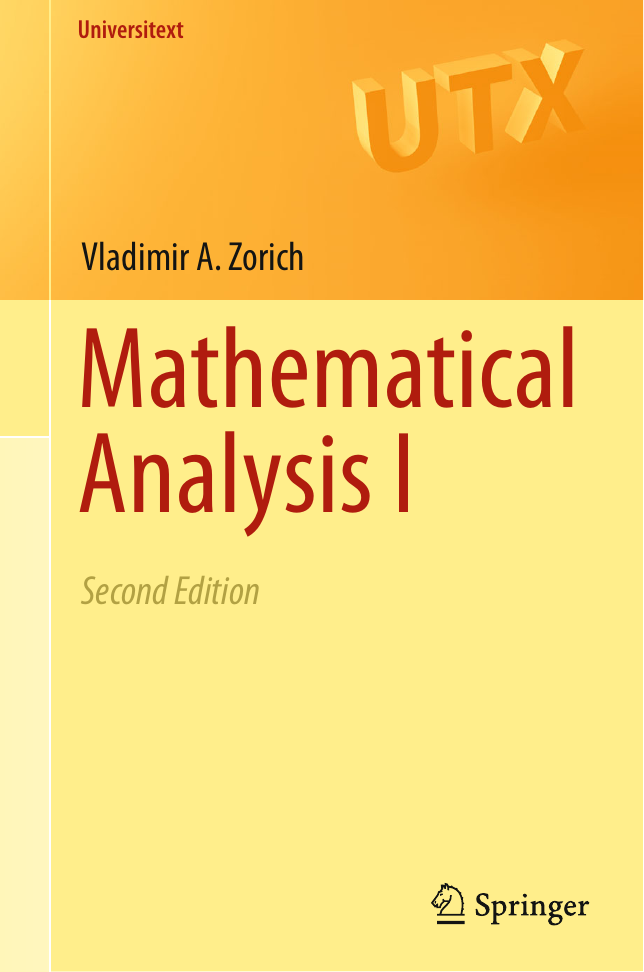


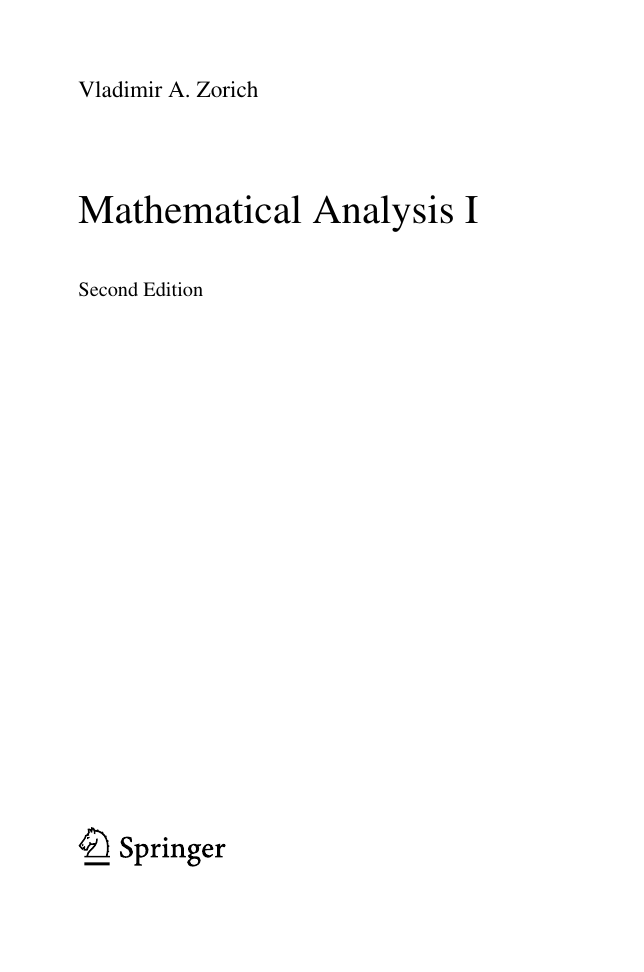
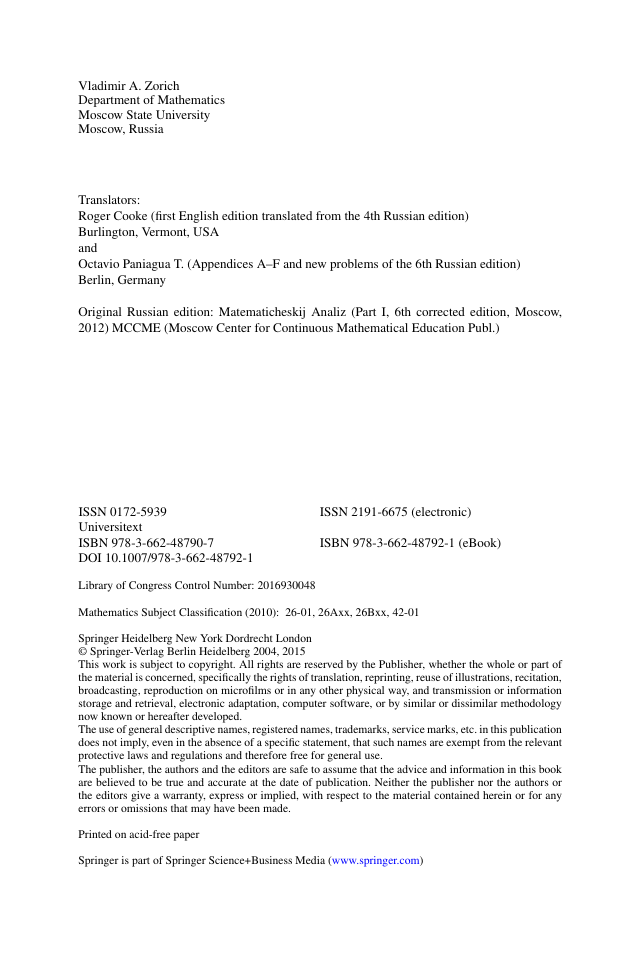
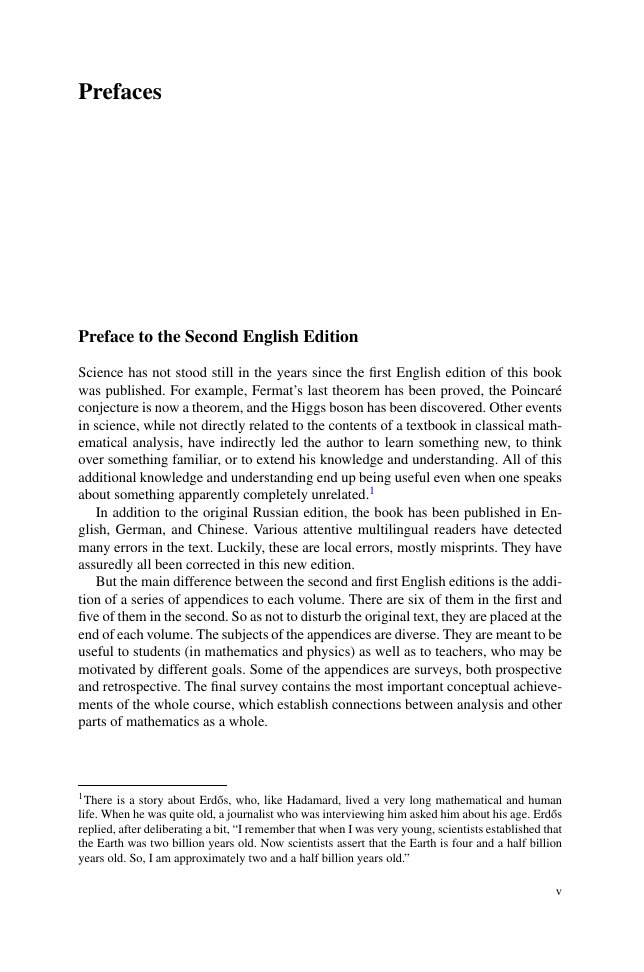
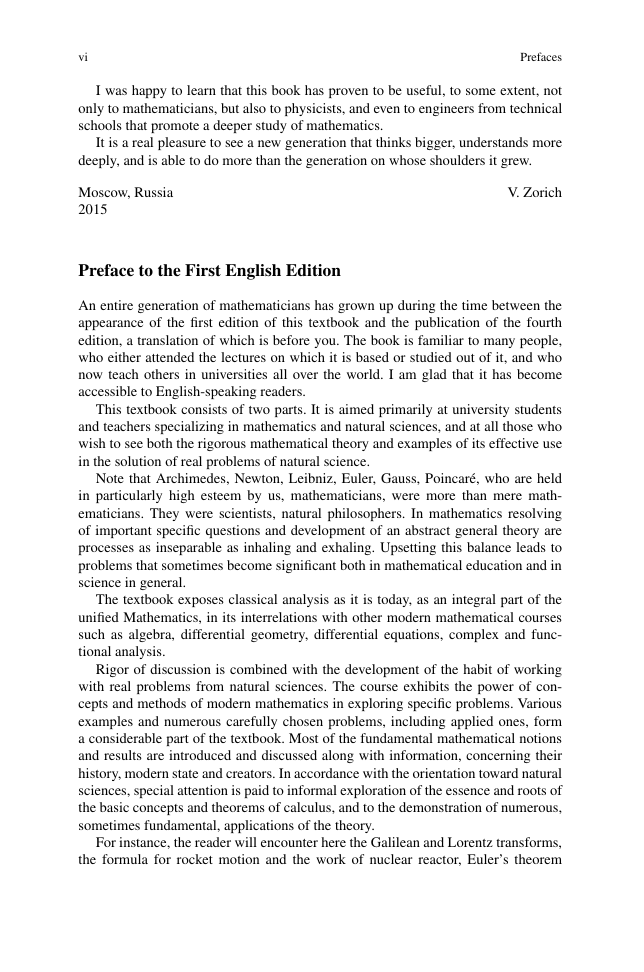
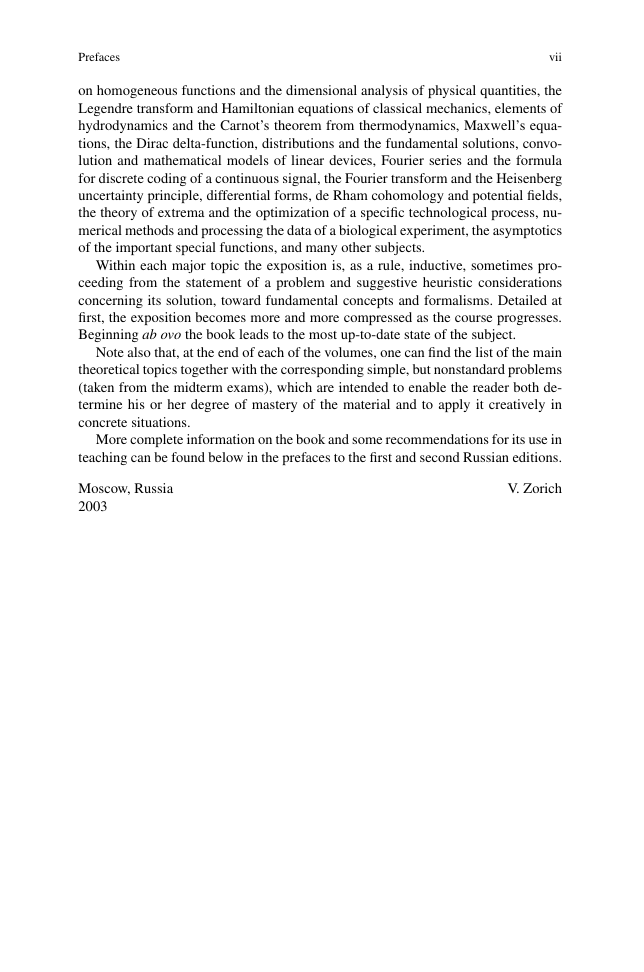








 2023年江西萍乡中考道德与法治真题及答案.doc
2023年江西萍乡中考道德与法治真题及答案.doc 2012年重庆南川中考生物真题及答案.doc
2012年重庆南川中考生物真题及答案.doc 2013年江西师范大学地理学综合及文艺理论基础考研真题.doc
2013年江西师范大学地理学综合及文艺理论基础考研真题.doc 2020年四川甘孜小升初语文真题及答案I卷.doc
2020年四川甘孜小升初语文真题及答案I卷.doc 2020年注册岩土工程师专业基础考试真题及答案.doc
2020年注册岩土工程师专业基础考试真题及答案.doc 2023-2024学年福建省厦门市九年级上学期数学月考试题及答案.doc
2023-2024学年福建省厦门市九年级上学期数学月考试题及答案.doc 2021-2022学年辽宁省沈阳市大东区九年级上学期语文期末试题及答案.doc
2021-2022学年辽宁省沈阳市大东区九年级上学期语文期末试题及答案.doc 2022-2023学年北京东城区初三第一学期物理期末试卷及答案.doc
2022-2023学年北京东城区初三第一学期物理期末试卷及答案.doc 2018上半年江西教师资格初中地理学科知识与教学能力真题及答案.doc
2018上半年江西教师资格初中地理学科知识与教学能力真题及答案.doc 2012年河北国家公务员申论考试真题及答案-省级.doc
2012年河北国家公务员申论考试真题及答案-省级.doc 2020-2021学年江苏省扬州市江都区邵樊片九年级上学期数学第一次质量检测试题及答案.doc
2020-2021学年江苏省扬州市江都区邵樊片九年级上学期数学第一次质量检测试题及答案.doc 2022下半年黑龙江教师资格证中学综合素质真题及答案.doc
2022下半年黑龙江教师资格证中学综合素质真题及答案.doc